Using Apocalypse World to Outline and Draft Your Own RPG
Here in Part 1, I’ll lay out Apocalypse World’s philosophy and foundation, describe the fit and purpose of its systems, and talk about which features are central to its workings and which aren’t.
This article was made possible by the generous support of my patrons. Please consider joining them by supporting me on Patreon.
This is adapted from a presentation I gave at Metatopia 2016. Pardon the PowerPointiness!
Here’s What
Apocalypse World offers a powerful, flexible framework you can use to outline, draft, and potentially finish your own roleplaying games. Dozens of creators, both experienced designers and first-timers, have used it with great success, and you can too. It’s not a game system as such, it’s an approach to game system design. It’s easy, and it’s a reliable way to get your creative vision quickly into a playable form.
1. Goal: Create a Playable Outline
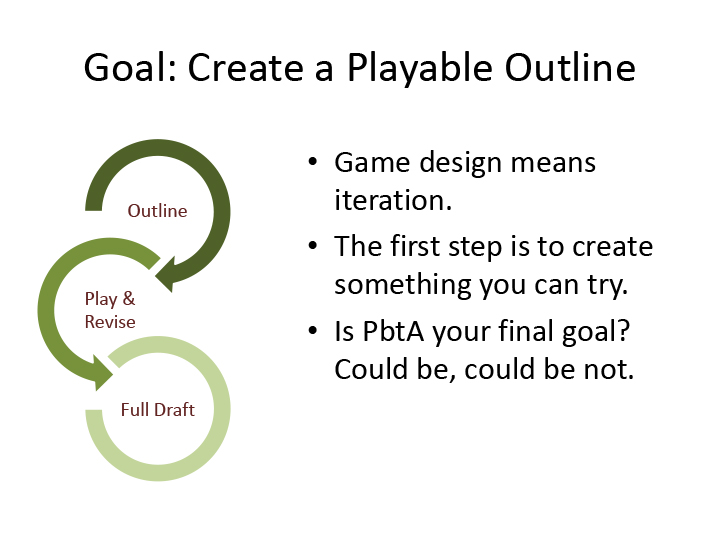
When I take it into my head to design a game, my first goal – my first, crucial, overriding goal – is to get something I can try. The process of game design for me is intensely iterative: a first stab, then play & revise, play & revise, play & revise.
Eventually, after one or ten or a hundred iterative cycles, depending on the game, I can make a full draft. Then comes a whole new process of play and revision, as I take the game public, and only once those cycles are done do I go on to finish the game for release.
So this article is about only that first goal: to make something you can try. The rest of the process, the vast bulk of the process, we’ll have to take up another time.
And I want to emphasize up-front: maybe, at the end of the iterative process, you have a PbtA game, and maybe you don’t anymore. That’s FANTASTIC. I know several games that started out as PbtA first drafts and wound up abandoning the framework completely somewhere along the way, and I consider them to be just as successful as applications of Apocalypse World to design as any PbtA game you could name.
My goal is to get you into the iterative cycle. Whatever comes out of it, is up to you.
2. “An Approach to System Design”?
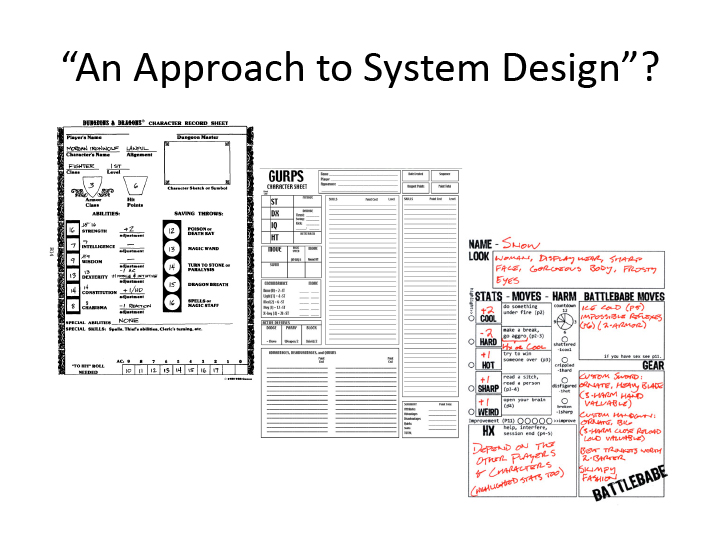
What do I mean when I say that PbtA isn’t a game system, it’s an approach to system design?
First we have the D&D approach to system design: races, classes, levels, hit points, you know the one.
Next we have the GURPS approach, which I guess was actually spearheaded by Champions: skill-based, point-buy, with an expansive description of your character’s competencies in any number of situations, and a limited set of mechanisms for testing them for success and failure.
Not pictured is the Forge approach, which appears in several of my games pre-Apocalypse World: a more-or-less specified situation of conflict, freeform character traits, and a universal conflict resolution system.
PbtA represents an approach to RPG design as broad as any of these. Choose two given PbtA games, and you shouldn’t expect them to be any more similar than two point-buy games or two Forge games.
PbtA isn’t a system you can adapt to different genres, like GURPS, d20, Fate, One-Roll Engine. It’s an approach, a framework, a vocabulary for designing new systems that work how you want them to work.
3. Apocalypse World’s Philosophy
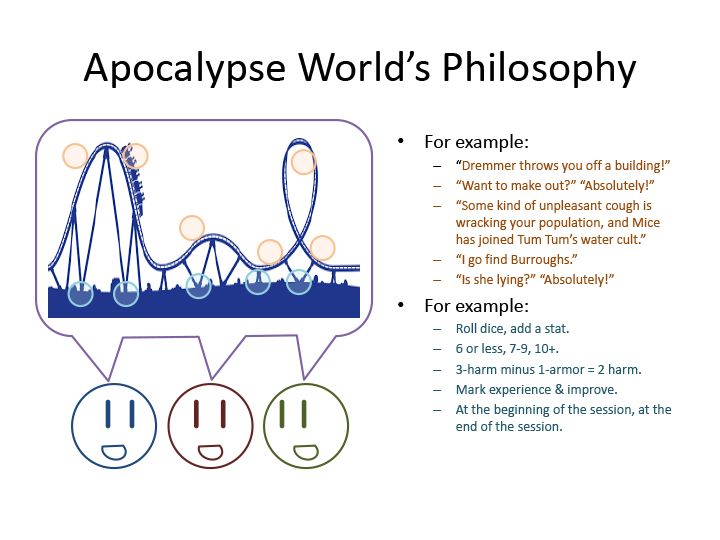
I love this little picture.
Here we have a playgroup having a conversation. They’re talking about fictional things – that’s the roller coaster – and they’re talking about real things – that’s the ground and structure beneath it.
Fictional things, in Apocalypse World’s case, like Dremmer and whether he’s throwing your character off a building, two characters and whether they’re making out, the hardhold’s population with its unpleasant cough and its water cult, and so on.
Real things, like the dice, the stat modifiers in your playbook, the number you’ve just rolled, the text of the moves.
Apocalypse World’s philosophy is: use the real things, the dice and stats and so on, to give momentum to the fictional things. The design is a roller coaster, with ascents, moments of suspense, dizzying drops, sudden curves, moments of terror, moments of exhilaration.
The game’s real components do a lot of different things in a lot of different ways, but they’re all in place to serve the excitement and momentum of the fictional action.
4. Apocalypse World’s Structure
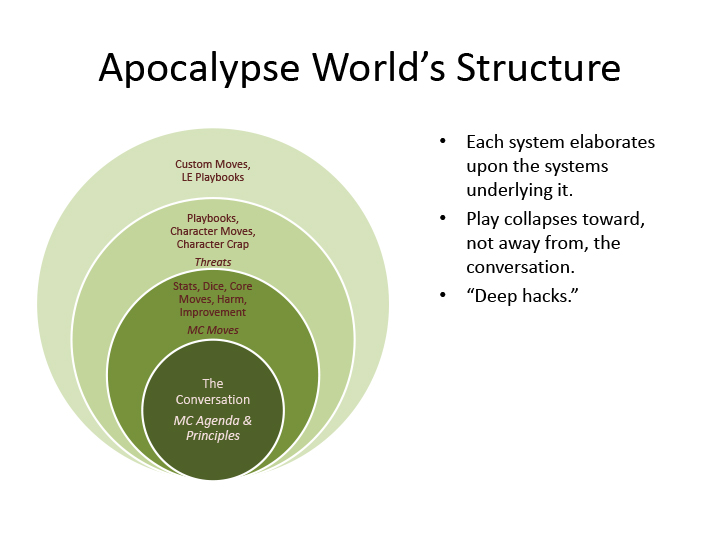
Apocalypse World is designed in concentric layers, like an onion.
- The innermost core is the structured conversation: you say what your characters do. The MC, following their agenda and principles, says what happens, and asks you what your characters do next.
- The next layer out builds on the conversation by adding core systems: stats, dice, basic moves, harm, improvement, MC moves, maybe some setting elements like the world’s psychic maelstrom.
- The next layer elaborates on the core systems by adding playbooks, with all their character moves, gear, and additional systems; and threats, with their types, impulses, moves, fronts, and maps.
- The outermost layer is even optional: it’s for your custom moves, your non-core playbooks, your MC experiments, stuff that doesn’t even appear in the book.
A crucial feature of Apocalypse World’s design is that these layers are designed to collapse gracefully inward:
- Forget the peripheral harm moves? That’s cool. You’re missing out, but the rules for harm have got you covered.
- Forget the rules for harm? that’s cool. You’re missing out, but the basic moves have got you covered. Just describe the splattering blood and let the moves handle the rest.
- Forget the basic moves? That’s cool. You’re missing out, but just remember that 10+ = hooray, 7-9 = mixed, and 6- = something worse happens.
- Don’t even feel like rolling the dice? Fair enough. You’re missing out, but the conversational structure still works.
Or:
- Don’t want to make custom moves and countdowns for your threats all the time? That’s cool. You’re missing out, but the threat types, impulses, and threat moves have got you covered.
- Don’t want to even write up your fronts and threats? That’s cool. You’re missing out, but your MC moves have got you covered.
- Forget your MC moves? That’s cool. You’re missing out, but as long as you remember your agenda and most of your principles and what to always say, you’ll be okay.
The whole game is built so that if you mess up a rule in play, you mostly just naturally fall back on the level below it, and you’re missing out a little but it works fine.
On Deep Hacks: “Deep hacks” is a term we sometimes use for PbtA games that don’t follow Apocalypse World’s template here. I’ll offer a couple of Meg’s and my own games as examples: in Murderous Ghosts, and in Mobile Frame Zero: Firebrands and its own offshoots, the conversations are structured so differently at the core that they require a whole different structure of elaboration and collapse.
For our purposes here, of getting a new game into a first-time playable outline, we’ll use Apocalypse World’s template: the same underlying conversation, elaborated into basic moves and other core systems, then further elaborated into characters and details as required.
5. Apocalypse World’s Systems
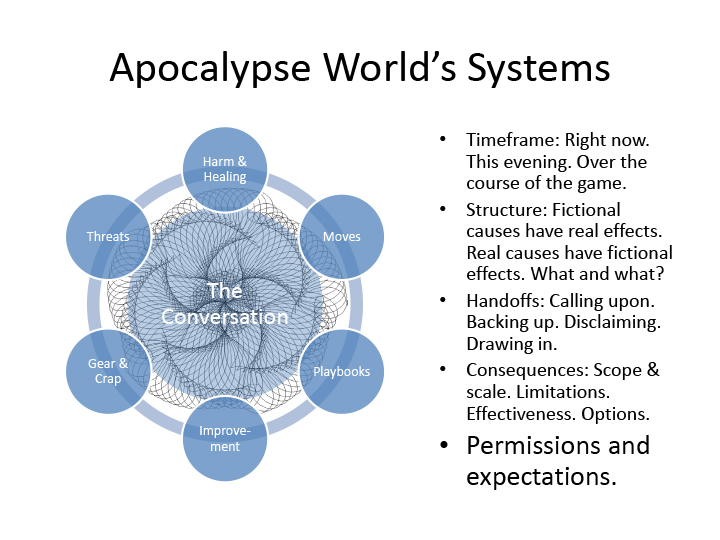
Let’s say that Apocalypse World has six core systems. Maybe it’s true! It depends how you slice ’em. But let’s say:
- Harm & Healing
- Moves
- Playbooks
- Improvement
- Gear & Crap
- Threats
Each of these contains oh who knows how many elements, subsystems, sub-subsystems. The point isn’t to make sure we can correctly list them, the point is to make sure we can see the relationships between them.
1. They don’t cycle in a circle like a windmill. They don’t cycle in a series like bicycle gears and their chain. They cycle erratically. This move leads to another move, but this other move leads to harm & healing, but this third move lets somebody mark improvement. When you take harm the Angel can spend gear & crap and make moves to bring you back from death and make changes to your playbook. Picture the moment of play bouncing like a pinball, ricocheting from system to system in a chaos of interacting forces, touching them all without ever settling into a repeating course.
2. They work over different timeframes. Which systems and subsystems act in the moment to moment of play? Which play out over the course of a single session? Which play out over many sessions, maybe even only over the whole course of the game?
3. They work by a pretty strict principle. The principle is: fictional causes have real-world effects. Real-world causes have fictional effects. Dremmer (fictional) goes to throw your character off a building (fictional). You (real) roll to act under fire, and come up with an 8 (real). What’s the fictional effect?
At the end of the session (real), which other character knows your character better (fictional)? That player (real) changes a number in their playbook (real).
Remember the roller coaster? The purpose of the real-world stuff is to keep the fictional stuff in motion. When a real cause has a fictional effect, that’s what holds the roller coaster up. When a fictional cause has a real effect, that’s what keeps the roller coaster from disconnecting, spinning off into insolidity.
4. As they cycle, they hand off to each other in a variety of ways. Sometimes a system puts the action on hold and consults another system for guidance on how to proceed, like the harm system calling on the harm move. Sometimes one system backs up another, like the experience system backing up the seduce or manipulate move. Sometimes a system disclaims control, like the MC move to tell you the possible consequences and ask what you do. Sometimes a system draws play in, like how reading a person lets you ask another player interesting questions.
5. They’re consequential. They can change the scope and scale of the characters’ actions and concerns, like how getting a gang lets a gunlugger take on enemies even more dangerous and numerous than they could before. They can limit the characters, like how your options collapse as you take harm past 6:00, or like how Dremmer can’t hold his gang together if he’s not there screaming at them to fight. They can better characters’ effectiveness at different timescales, like +1 forward vs +1 to a stat vs gaining a new move. Or worsen them instead. They can open and close whole doors, whole potential futures, like when you first chose your playbook or when you choose to change to a new one.
The point is that every system changes whatever it touches. You can’t bring any system into play and expect play to continue unchanged.
6. In sum, the game’s rules, subsystems, and sub-subsystems work together to create a system of permissions and expectations. As a player, as the MC, here is what you’re permitted to do, and here is what we expect you to do.
Knowing what you’re allowed to do, and what you’re expected to do, lets you act with your feet under you.
6. “Accidents” of the System
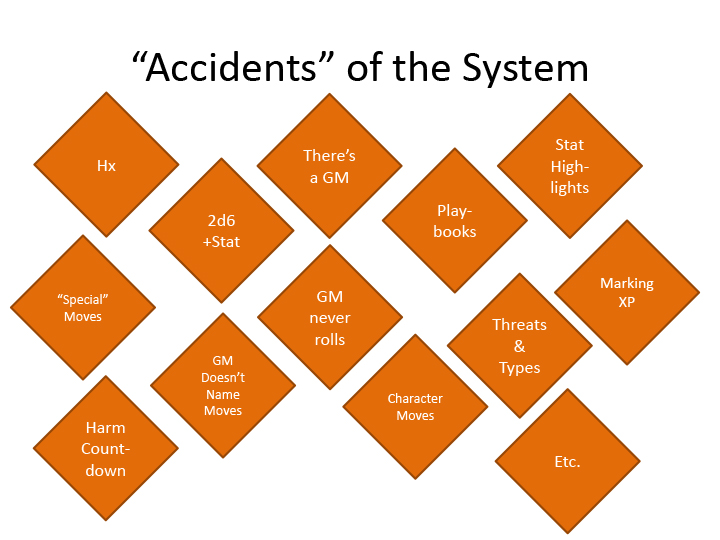
These are all features of Apocalypse World, but it’s only that historical accident that makes them prominent in PbtA. When we created Apocalypse World, we made a million design decision that were specific to Apocalypse World, that served Apocalypse World’s very particular cinematic-post-apocalyptic-narrativist needs. None of these are important to PbtA at large. When you’re working on your own PbtA game, you can and should reconsider each one of them, and only keep the ones – if any! – that serve your game.
I’ll highlight a few in particular:
- Playbooks. Playbooks are pretty cool, and I knew they’d catch on. What I didn’t expect was for them to become one of the dominant PbtA conventions. I figured that by now we’d have example after example of PbtA games without playbooks, with the more conventional setup of one character sheet / one character creation process for all the characters.
You know the rule in Apocalypse World that everyone has to choose a different playbook? You might be interested to know, as a point of trivia, that the reason for this isn’t niche protection or whatever, it’s just so the MC doesn’t have to show up to the first session with multiple copies of every playbook. - 2d6+Stat and GM Never Rolls. Before we made Apocalypse World, we were working on a fantasy game called Storming the Wizard’s Tower. A lot of Apocalypse World’s design comes directly from that game, including several of the basic moves and some of the other subsystems. Storming the Wizard’s Tower used opposed d6 pools: roll a handful of dice, count the hits (4-6), and compare with the hits the GM or other player rolled.
Apocalypse World doesn’t use opposed die pools for two main reasons. The first is the straight-up commonality and familiarity of 2d6. The second is that we kept working on Storming the Wizard’s Tower for a while after we started work on Apocalypse World, and I wanted to keep them separate in my head. - Stat Highlights and Marking XP. Dungeon World was one of the first three PbtA games after Apocalypse World, and we were thrilled that it didn’t use stat highlights. The question of when to mark XP is wide open, and every possible answer is a good possible answer. It’s good that stat highlights haven’t stuck as a strong convention.
Of course, the question of whether to mark XP at all is ALSO wide open. We’d love to see more games posing more answers to it, too.
So the upshot is, the conventions of PbtA design are just that, conventions. As a designer, you choose which conventions to follow, which to ignore, and which to defy. Trust your game! It knows.
7. The End of Part I
Recall that the point of all of this is to create something you can get to the table to try, so that you can begin the iterative process of developing and finishing your game.
In Part 2, I’ll walk you through the process of starting with a game idea and using Apocalypse World’s approach to draft it into a playable outline.

Thanks for reading!
Next Installments:
- In Part 2, I walk through the beginnings of taking Apocalypse World’s parts and using them as the basis for a whole new game.
- In Part 3, I dive back into Apocalypse World’s basic moves. I go through them one by one to talk about how and why they work the way they do.
- In Part 4, I talk about playbooks, by request. What are they, do you want them in your game, and what are the alternatives?
- In Part 5, I take a quick aside to talk about some different ways that moves can fit into the conversation of play.
- In Part 6, I use an Ursula K. LeGuin quote — you probably already know the one — as an outline for alternative models to Apocalypse World’s model of conflict.
- Part 7’s a good old-fashioned Q&A, in rounds: Round 1, Round 2, Round 3 (the lightning round!), & Q&A Round 4 (the Final Round!)
- In Part 8, I share my six best, most reliable tricks for drafting interesting moves.
- In Part 9, I lay some groundwork for the idea of underlying models by pointing out a crucial feature of Apocalypse World.
- In Part 10, I develop the idea of underlying models further, with 2 solid examples and 1 tentative one.
- In Part 11, I explore a few of the dice systems we’ve used in our PbtA games.
- In Part 12, I point out a detail in Apocalypse World’s playbook moves that you might have missed

Sam says:
There is some interesting stuff in here for sure – that you consider fallback a crucial aspect of the approach is very interesting, and I think this is especially cogent about a lot of things that RPG designers often leaves implicit, even when attempting to speak explicitly about RPG design, but I’m not sure I buy the overall pitch, which is funny because I’ve played a lot of PbtA and used it as an approach pretty much as described here!
Maybe another way to put it: couldn’t I say almost all of these same things about D&D? You could slice up its systems similarly, and if you looked at their relationships, well: its systems cycle erratically, they work over different timeframes, fictional causes have real-world effects, real-world causes have fictional effects, they hand off to each other in a variety of ways as they cycle, and they’re consequential. For the most part, I would say D&D has a similar philosophy re the roller coaster picture too. Stripped of the “accidents”, viewed primarily as the relationships between the parts of the systems and the fundamental goals, it seems to me from this presentation that PbtA is the *same* design philosophy as D&D, which I don’t really think is true!
Trying to think about what makes PbtA unique as an approach to design, I think for me it’s that it is somewhat close to a *minimal* system with these things. I think that might be one of the reasons why the games tend to feel very concrete and hackable, why you can “see their bones”. It isn’t just that the systems in, say, Apocalypse World have these properties, but that there is just enough complexity to the systems to get these things. There are just enough mechanics that they can operate over a variety of timescales – remove more than a couple and you wouldn’t have much variety in that respect. There are just enough systems that they can cycle erratically – pull out a few and it’d be very hard to avoid periodicity. There are handoffs, but not a ton of them: this isn’t Shadowrun where I’m consulting a table on wall thickness, weapon damage, armor, damage, piercing, a character’s shooting skill, their (and the target’s) cyberware, magical effects on them, etc. Look at how many systems a spell description in D&D editions touches – contrast PbtA where most moves typically touch just one or two other systems at a time (sometimes more, but rarely as many as something like D&D).
This has always seemed like a big part of the PbtA philosophy in general to me. It’s not just that the rules achieve these things, but that they are closer to a minimal set that can achieve them than most other approaches that result in games that have these same properties. Minimalism has always seemed like a pretty big part of PbtA – it obviously isn’t hyper-radical about minimalism, but I’ve always seen a lot of it in a lot of places in the approach.
The MC Moves, for instance, have a similar feel. Apocalypse World would be a very different game if the MC Moves said “here are some suggestions for some kinds of things you might say whenever you feel like it”. The fact that there isn’t an MC Move for “whatever you think an NPC would say, say it” is a huge part of why they work so well, and was actually a pretty huge shift in the way I thought about GMing when I first encountered Apocalypse World.
I think this is implicit in most people’s use of PbtA as an approach to systems design too. When people use PbtA to outline their game, they don’t just use Moves, they, perhaps without realizing they’re doing it, usually design them in a similar way where they touch other systems, but in a limited way. It’s not too hard to imagine a really baroque elaboration of PbtA, with tons of moving parts everywhere, Moves that touch a dozen systems all at once all the time, hundreds of moves with dozens that occur at each timescale, etc. It’s not too hard to imagine a PbtA that basically is D&D, just in the terminology of PbtA. But I think it’s telling that this isn’t really what people usually mean when they say “PbtA”, and isn’t the kind of game people usually produce when they use this approach to system design.
Vincent Baker says:
Sorry to keep you waiting! Here’s Part 2: https://lumpley.games/2020/02/29/powered-by-the-apocalypse-part-2/
I hope it answers some of your questions. If it doesn’t, please ask them again?
Graham says:
Hi Vincent! I like this a lot.
I totally get design by iteration and I love the rollercoaster analogy.
I get the fiction/real-world split and I can imagine using it in my design, but I don’t quite know how.
I’d love to know more about AW’s structures, especially their interacting cycles of play, because I don’t really get how to use those ideas in my design.
Vincent Baker says:
Sorry to keep you waiting! Here’s Part 2: https://lumpley.games/2020/02/29/powered-by-the-apocalypse-part-2/
I wanted to have it out before I tackled your questions, which are doozies.
weekend reading 46 | enjoying the postapocalypse says:
[…] Powered by the Apocalypse, part 1: Using Apocalypse World to Outline and Draft Your Own RPG erklärt Vincent Baker, einer der Köpfe hinter dem immer beliebter werdenden RPG-Framework Powerd […]
16 December 2019–5 January 2020: Pay-What-You-Want, Year in Review, New GM Month — d100 News says:
[…] Vincent Baker begins a series of articles on the creation of Powered by the Apocalypse games. […]
GAMES NEWS! 30/03/20 - Shut Up & Sit Down says:
[…] offering unique and useful insight. And Vincent D Baker is part way through an incredible series on the design principles behind Apocalypse World and his definition of a Powered by the Apocalypse design process. It’s brilliant […]
GAMES NEWS! 30/03/20 - Shut Up & Sit Down - Best Games 2020 says:
[…] perception. And Vincent D Baker is an element approach by means of an unbelievable sequence on the design principles behind Apocalypse World and his definition of a Powered by the Apocalypse design course of. It’s sensible […]
GAMES NEWS! 30/03/20 – Middle Irth says:
[…] offering unique and useful insight. And Vincent D Baker is part way through an incredible series on the design principles behind Apocalypse World and his definition of a Powered by the Apocalypse design process. It’s brilliant […]
Let’s Design a Powered by the Apocalypse RPG pt 7: Death and death moves – Sinister Beard Games says:
[…] this series we’ll be using Vincent Baker’s blog series Powered by the Apocalypse and Brandon Leon-Gamebtta’s twitter thread of various PbtA move shapes. The view from the […]
Jack says:
[…] perception. And Vincent D Baker is an element approach by means of an unbelievable sequence on the design principles behind Apocalypse World and his definition of a Powered by the Apocalypse design course of. It’s sensible […]
Links for Designing PbtA TTRPGs – Troy Press says:
[…] Fourth, read @lumpleygames‘ series of blog posts on “Using Apocalypse World to Outline and Draft Your Own RPG.” […]
João Talassa says:
In “Apocalypse’s World Philosophy” above, when you say “The design is” in “ The design is a roller coaster, with ascents, moments of suspense, dizzying drops, sudden curves, moments of terror, moments of exhilaration”, I think it would make more sense if instead of “The design is…” you meant “The ficcional things are…”. Above that, in the picture, you map the fictional things to the roller coaster.
João Talassa says:
Right after you write: “Remember the roller coaster? The purpose of the real-world stuff is to keep the fictional stuff in motion. When a real cause has a fictional effect, that’s what holds the roller coaster up. When a fictional cause has a real effect, that’s what keeps the roller coaster from disconnecting, spinning off into insolidity.” – here you equate the roller coaster to the system in the sense of “real causes have ficcional effects and ficcional causes have real effects”. Of course something can be both a cause and an effect in itself, relating to different other things. On light of that, maybe what is causing some cognitive imbalance is the mapping of the rollercoaster (only) to the ficcional events in the picture. By that I mean: if you are using the rollercoaster as a methafor, maybe is a good ideia to keep the same methafor. Or am I seeing this all wrong? Thanks!
Vincent Baker says:
A little wrong!
The structure supporting the track is part of the roller coaster. I map the fictional things to the track, and the real-world things to the structure supporting the track, but they’re both part of the roller coaster.
The game’s design is like a roller coaster, with real-world stuff supporting the fictional stuff, and together the real-world stuff and fictional stuff have ascents, moments of suspense, dizzying drops, sudden curves, moments of terror, moments of exhilaration.
João Talassa says:
Ok. I see you intent. Thanks for the reply!
Radio Rôliste #114 : Pour que les Bambins Tuent des Astronautes | Radio Rôliste says:
[…] qu’est le PbTA pour Meguey et Vincent Baker : — Le label — La démarche de conception — Les 6 jeux « eye-openers » Les “schismes” : — Les jeux “BoB”/Belonging outside […]
Apocalypse World – Pjaltekongen says:
[…] lag (terninger, stats) og fiktionslaget. Som vist på Vincents illustration herunder (fra en artikelserie som jeg håber at vende tilbage […]
Jacob says:
Hej from Sweden and thanks for this, like, a lot!
Could I have your permission to reproduce images from this post in my blog (with due credit, links, and praise)?
Game systems to replace D&D 5E - Argent Lion Games says:
[…] Using Apocalypse World to Outline and Draft Your Own RPG by D. Vincent Baker […]
La mesa del invitado 2: Lobo Blanco – Rolerøs No Representativøs says:
[…] A partir de aquí, vamos a comenzar con nuestra propuesta para hoy. Partimos del artículo “PbtA, RPG Design & Development, Powered by the Apocalypse, part 1”. En concreto tomaremos en consideración el punto 4 “Apocalypse Wolrd’s Structure”. En el Vincent Baker nos habla del diseño mediante círculos concéntricos, similares a las capas de una cebolla, que usa para el diseño de juegos PbtA. Aquí puedes leer el articulo completo: https://lumpley.games/2019/12/30/powered-by-the-apocalypse-part-1/ […]
A Catch-All Move in PbtA Games – Troy Press says:
[…] Baker in his blog series on drafting PbtA games […]
Pablo says:
[this was accidentally posted as a reply to a comment… it wasn’t meant as such, it was meant as a question about the article, so I’m reposting here]
I guess I have this one problem with the definition of what is fundamental or core to AW (meaning the philosophy, structure and systems subsection of the article) vs what you deem “accidental” to it: I can’t think of any game, be it d20, Hero, ORE, Fate, PDQ, Storyteller, or any other type of system, which does not adhere to the fundamentals as described here.
Is the point then that PbtA is an approach to designing games that conceptualizes them first and foremost as a conversation? Or, if I’m egregiously wrong, could you provide a counter example?
Vincent Baker says:
I’m not positive that I understand your question!
If you’re looking for an explanation about what “PbtA” means, there’s “What is PbtA?” here: https://lumpley.games/2023/11/22/what-is-pbta/
If you’re looking for something that Apocalypse World does kind of differently from many other RPGs, there’s “PbtA Part 9: That’s What’s Happening” here: https://lumpley.games/2023/07/17/powered-by-the-apocalypse-part-9-thats-whats-happening/
My point in the “Accidents of the system” section is, you can make a PbtA game that doesn’t match Apocalypse World in any given particular. It’s cool for a PbtA game to roll different dice, be GMless, have no moves, have no playbooks, etc. None of those things are essential to PbtA.
Pablo says:
My question was geared towards what, to me, reads like a general theory of RPGs that seems to fit AW as well as it fits D&D or GURPS. If you remove the accidents, what you deem nonessential, I can’t see how the model you setup does not apply to every game.
So it seems like it is a theory for understanding games ( the conversation, the fallbacks, the cascading systems), not a definition of a type of game that’s different like, say, FATE is different than D&D.
The question could be “why isn’t D&D a PbtA”? Note that, in the linked example (part 9) , which nods heavily to DnD, you differentiate from explicitly based on moves. I tend to feel that moves are a distinctive sine qua non feature of PbtAs, so that explanation makes sense to me. However, moves here are listed here as part of the accidents, so I’m trying to square that circle.
Vincent Baker says:
What do you make of the “What is PbtA?” article?
D&D isn’t PbtA because it wasn’t inspired by Apocalypse World.
Part 9 lays out a way that Apocalypse World itself is different from D&D and others, yes. However, you can make a game that’s inspired by Apocalypse World that doesn’t use moves, if you want to — if some other feature of Apocalypse World inspires you.
To understand what makes an individual game PbtA or not, only the game’s creator can tell you for sure. I can tell you why Murderous Ghosts or The King Is Dead are PbtA, for instance, even though they don’t use Apocalypse World’s playbooks, dice, GMs, or moves.
Vincent Baker says:
Oh! Maybe you just don’t agree with my definition, that PbtA means games inspired by Apocalypse World. Do you have a different definition that you’d like to propose?
Pablo says:
Well, when I ask why is D&D not a PbtA, the underlying question is in reference to this article, where you outline a particular philosophy and structure that you deem core to AW. I find that outline broad enough to fit any RPG, so the question becomes: how does D&D ( or any other game from GURPS to Dread) not abide by the philosophy, structure and systems outlined in #3, #4 and #5?
Vincent Baker says:
I’m not saying they don’t!
In this article, I’m describing how Apocalypse World’s design works under the hood. I’m not saying anything about D&D or other games. I’m certainly not saying that Apocalypse World is unique in these ways, that’d be absurd. Apocalypse World is a pretty normal roleplaying game with a couple of interesting features.
If you want to use Apocalypse World as a model to draft your own game, I think it’s important that you see the philosophy and principles underneath its design, that’s all.
Designer Diary for Planet of the Week – Troy Press says:
[…] Playbooks are actually two inserts: one for your character’s background (cyborg, cross-cultural, telepath, etc.), one for your specialty (pilot, doctor, security, etc.). As I designed playbooks, it’s been fun to re-re-read Vincent Baker’s long series of blog posts on PbtA design. […]
A Queer OS Powered by the Apocalypse: Speculating on Feminist Platforms through TTRPG Engines | Analog Game Studies says:
[…] D. Vincent Baker, “Powered by the Apocalypse, Part 1: Using Apocalypse World to Outline and Draft Your Own RPG,” Lumpley Games, https://lumpley.games/2019/12/30/powered-by-the-apocalypse-part-1/. […]